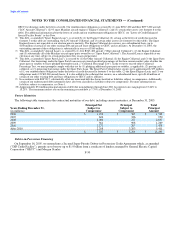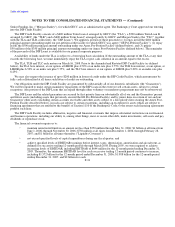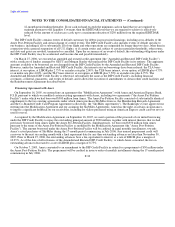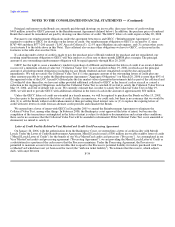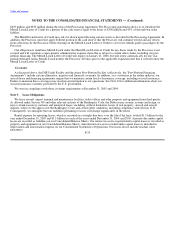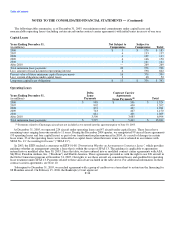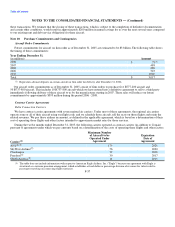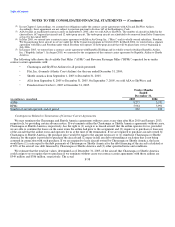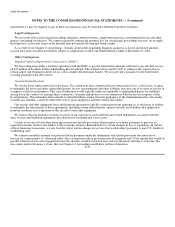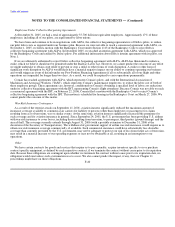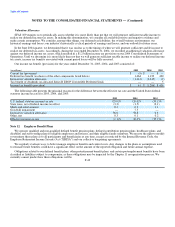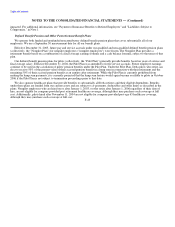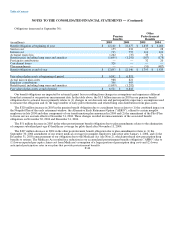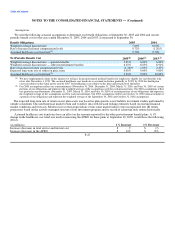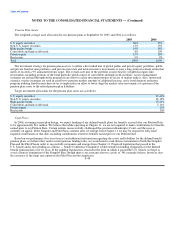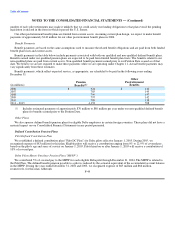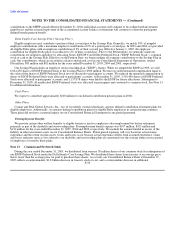Delta Airlines 2005 Annual Report Download - page 102
Download and view the complete annual report
Please find page 102 of the 2005 Delta Airlines annual report below. You can navigate through the pages in the report by either clicking on the pages listed below, or by using the keyword search tool below to find specific information within the annual report.
Table of Contents
NOTES TO THE CONSOLIDATED FINANCIAL STATEMENTS — (Continued)
Employees Under Collective Bargaining Agreements
At December 31, 2005, we had a total of approximately 55,700 full-time equivalent employees. Approximately 17% of these
employees, including all of our pilots, are represented by labor unions.
We have been and continue to be in negotiations with ALPA, the collective bargaining representative of Delta's pilots, to reduce
our pilot labor costs as required under our business plan. Because we were not able to reach a consensual agreement with ALPA, on
November 1, 2005, we filed a motion with the Bankruptcy Court under Section 1113 of the Bankruptcy Code to reject Delta's
collective bargaining agreement with ALPA. In December 2005, we reached an interim agreement with ALPA, which was approved
by the Bankruptcy Court and ratified by Delta's pilots. For additional information about Delta's interim agreement with its pilots, see
Note 1.
If we are ultimately authorized to reject Delta's collective bargaining agreement with ALPA, ALPA has threatened to initiate a
strike, which we believe should not be permitted under the Railway Labor Act. However, we cannot predict the outcome of any effort
we might undertake to obtain court relief to prevent or stop a strike or other forms of work disruption. A strike or other form of
significant work disruption by ALPA would likely have a material negative impact on our ability to continue operating our business
and would trigger an event of default under our Post-Petition Financing Agreements if all or substantially all of our flight and other
operations are suspended for longer than two days. As a result, we could be required to cease operations permanently.
Comair has reached agreements with ALPA, which represents Comair's pilots, and with the International Association of
Machinists and Aerospace Workers ("IAM"), which represents Comair's maintenance employees, to reduce the labor cost of both of
these employee groups. These agreements are, however, conditioned on Comair's obtaining a specified level of labor cost reductions
under its collective bargaining agreement with the IBT, representing Comair's flight attendants. Because Comair was not able to reach
a consensual agreement with the IBT, on February 22, 2006, Comair filed a motion with the Bankruptcy Court to reject Comair's
collective bargaining agreement with the IBT. This motion is scheduled for hearing in the Bankruptcy Court on March 27, 2006. We
cannot predict the outcome of this matter.
War-Risk Insurance Contingency
As a result of the terrorist attacks on September 11, 2001, aviation insurers significantly reduced the maximum amount of
insurance coverage available to commercial air carriers for liability to persons (other than employees or passengers) for claims
resulting from acts of terrorism, war or similar events. At the same time, aviation insurers significantly increased the premiums for
such coverage and for aviation insurance in general. Since September 24, 2001, the U.S. government has been providing U.S. airlines
with war-risk insurance to cover losses, including those resulting from terrorism, to passengers, third parties (ground damage) and the
aircraft hull. The coverage currently extends through August 31, 2006 (with a possible extension to December 31, 2006 at the
discretion of the Secretary of Transportation). The withdrawal of government support of airline war-risk insurance would require us to
obtain war-risk insurance coverage commercially, if available. Such commercial insurance could have substantially less desirable
coverage than currently provided by the U.S. government, may not be adequate to protect our risk of loss from future acts of terrorism,
may result in a material increase to our operating expenses or may not be obtainable at all, resulting in an interruption to our
operations.
Other
We have certain contracts for goods and services that require us to pay a penalty, acquire inventory specific to us or purchase
contract specific equipment, as defined by each respective contract, if we terminate the contract without cause prior to its expiration
date. Because these obligations are contingent upon whether we terminate the contract without cause prior to its expiration date, no
obligation would exist unless such a termination was to occur. We also cannot predict the impact, if any, that our Chapter 11
proceedings might have on these obligations. F-40


